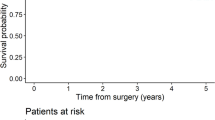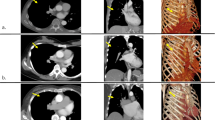Abstract
Aims
This analysis from the German Mitral Valve Registry investigates the impact of the learning curve with the MitraClip® technique on procedural success and complications.
Methods and results
Consecutive patients treated since 2009 in centers that performed more than 50 transcatheter mitral repairs were included. Results of the first half of the patients were compared to those of the second. Altogether 496 patients from 10 centers were included. Patients treated later had less common severe heart failure symptoms (patients with NYHA IV: 22.1 vs. 14.5 %, p < 0.05). The EuroSCORE I (22.0 vs. 23.0 %, p = ns) and Society of Thoracic Surgeons (STS) score (7.5 vs. 9.5 %, p = ns) did not differ between both groups. Procedural success was 95.6 % (238/249) in the first cases and 94.7 % (232/245, p = ns) subsequently. Also procedural time (104.3 vs. 119 min, p = ns) and complications did not decrease over time.
Conclusion
A learning curve using the MitraClip® device does not appear to significantly affect acute MR reduction, hospital and 30-day mortality. Most likely, the proctor system leads to already high initial procedure success and relatively short procedure time.

Similar content being viewed by others
References
Feldman T, Foster E, Glower DD, Kar S, Rinaldi MJ, Fail PS, Smalling RW, Siegel R, Rose GA, Engeron E, Loghin C, Trento A, Skipper ER, Fudge T, Letsou GV, Massaro JM, Mauri L (2011) Percutaneous repair or surgery for mitral regurgitation. N Engl J Med 364:1395–1406
Feldman T, Kar S, Rinaldi M, Fail P, Hermiller J, Smalling R, Whitlow PL, Gray W, Low R, Herrmann HC, Lim S, Foster E, Glower D (2009) Percutaneous mitral repair with the MitraClip system: safety and midterm durability in the initial EVEREST (Endovascular Valve Edge-to-Edge REpair Study) cohort. J Am Coll Cardiol 54:686–694
Schillinger W, Athanasiou T, Weicken N, Berg L, Tichelbacker T, Puls M, Hunlich M, Wachter R, Helms HJ, Seipelt R, Schondube FA, Hasenfuss G (2011) Impact of the learning curve on outcomes after percutaneous mitral valve repair with MitraClip(R) and lessons learned after the first 75 consecutive patients. Eur J Heart Fail 13:1331–1339
Baldus S, Schillinger W, Franzen O, Bekeredjian R, Sievert H, Schofer J, Kuck KH, Konorza T, Mollmann H, Hehrlein C, Ouarrak T, Senges J, Meinertz T (2012) MitraClip therapy in daily clinical practice: initial results from the German transcatheter mitral valve interventions (TRAMI) registry. Eur J Heart Fail 14:1050–1055
Franzen O, Baldus S, Rudolph V, Meyer S, Knap M, Koschyk D, Treede H, Barmeyer A, Schofer J, Costard-Jackle A, Schluter M, Reichenspurner H, Meinertz T (2010) Acute outcomes of MitraClip therapy for mitral regurgitation in high-surgical-risk patients: emphasis on adverse valve morphology and severe left ventricular dysfunction. Eur Heart J 31:1373–1381
Zoghbi WA, Enriquez-Sarano M, Foster E, Grayburn PA, Kraft CD, Levine RA, Nihoyannopoulos P, Otto CM, Quinones MA, Rakowski H, Stewart WJ, Waggoner A, Weissman NJ (2003) Recommendations for evaluation of the severity of native valvular regurgitation with two-dimensional and Doppler echocardiography. J Am Soc Echocardiogr 16:777–802
Roques F, Nashef SA, Michel P (2001) Risk factors for early mortality after valve surgery in Europe in the 1990s: lessons from the EuroSCORE pilot program. J Heart Valve Dis 10:572–577 (discussion 577–8)
Feldman T, Wasserman HS, Herrmann HC, Gray W, Block PC, Whitlow P, St Goar F, Rodriguez L, Silvestry F, Schwartz A, Sanborn TA, Condado JA, Foster E (2005) Percutaneous mitral valve repair using the edge-to-edge technique: six-month results of the EVEREST Phase I Clinical Trial. J Am Coll Cardiol 46:2134–2140
Alfieri O, Maisano F, De Bonis M, Stefano PL, Torracca L, Oppizzi M, La Canna G (2001) The double-orifice technique in mitral valve repair: a simple solution for complex problems. J Thorac Cardiovasc Surg 122:674–681
Gaemperli O, Moccetti M, Surder D, Biaggi P, Hurlimann D, Kretschmar O, Buehler I, Bettex D, Felix C, Luscher TF, Falk V, Grunenfelder J, Corti R (2011) Acute haemodynamic changes after percutaneous mitral valve repair: relation to mid-term outcomes. Heart 98:126–132
Ihlemann N, Franzen O, Jorgensen E, Hansen PB, Hassager C, Moller JE, Sondergaard L (2011) Promising results after percutaneous mitral valve repair. Dan Med Bull 58:A4299
Pleger ST, Mereles D, Schulz-Schonhagen M, Krumsdorf U, Chorianopoulos E, Rottbauer W, Katus HA, Bekeredjian R (2011) Acute safety and 30-day outcome after percutaneous edge-to-edge repair of mitral regurgitation in very high-risk patients. Am J Cardiol 108:1478–1482
Tamburino C, Ussia GP, Maisano F, Capodanno D, La Canna G, Scandura S, Colombo A, Giacomini A, Michev I, Mangiafico S, Cammalleri V, Barbanti M, Alfieri O (2010) Percutaneous mitral valve repair with the MitraClip system: acute results from a real world setting. Eur Heart J 31:1382–1389
Van den Branden BJ, Post MC, Swaans MJ, Rensing BJ, Eefting FD, Plokker HW, Jaarsma W, Van der Heyden JA (2010) Percutaneous mitral valve repair using the edge-to-edge technique in a high-risk population. Neth Heart J 18:437–443
Franzen O (2011) What have we learned from the EU experience. TCT
Paranskaya L, Turan I, Kische S, Nienaber C, Ince H (2011) Rapid pacing facilitates grasping and MitraClip implantation in severe mitral leaflet prolapse. Clin Res Cardiol 101:69–71
Mayr NP, Martin K, Hausleiter J, Brown A, Tassani P (2011) Ventilation manoeuvres facilitate MitraClip placement. Heart 97:1717 (author reply 1717)
Vahanian A, Alfieri O, Andreotti F, Antunes MJ, Baron-Esquivias G, Baumgartner H, Borger MA, Carrel TP, De Bonis M, Evangelista A, Falk V, Iung B, Lancellotti P, Pierard L, Price S, Schafers HJ, Schuler G, Stepinska J, Swedberg K, Takkenberg J, Von Oppell UO, Windecker S, Zamorano JL, Zembala M (2012) Guidelines on the management of valvular heart disease (version 2012). Eur Heart J 33:2451–2496
Braun D, Lesevic H, Orban M, Michalk F, Barthel P, Hoppe K, Sonne C, Pache J, Mehilli J, Kastrati A, Hausleiter J, Massberg S (2013) Percutaneous edge-to-edge repair of the mitral valve in patients with degenerative versus functional mitral regurgitation. Catheter Cardiovasc Interv. doi:10.1002/ccd.25331
Rudolph V, Knap M, Franzen O, Schluter M, de Vries T, Conradi L, Schirmer J, Treede H, Wegscheider K, Costard-Jackle A, Meinertz T, Reichenspurner H, Baldus S (2011) Echocardiographic and clinical outcomes of MitraClip therapy in patients not amenable to surgery. J Am Coll Cardiol 58:2190–2195
Grasso C, Capodanno D, Scandura S, Cannata S, Imme S, Mangiafico S, Pistritto A, Ministeri M, Barbanti M, Caggegi A, Chiaranda M, Dipasqua F, Giaquinta S, Occhipinti M, Ussia G, Tamburino C (2013) One- and twelve-month safety and efficacy outcomes of patients undergoing edge-to-edge percutaneous mitral valve repair (from the GRASP Registry). Am J Cardiol 111:1482–1487
Boekstegers P, Hausleiter J, Baldus S, von Bardeleben RS, Beucher H, Butter C, Franzen O, Hoffmann R, Ince H, Kuck KH, Rudolph V, Schafer U, Schillinger W, Wunderlich N (2014) Percutaneous interventional mitral regurgitation treatment using the Mitra-Clip system. Clin Res Cardiol 103:85–96
Corti R (2012) Real-word european experience with transcatheter treatment of significant mitral regurgitation: demographies and procedural outcomes. PCR London Valves
Paranskaya L, Kische S, Bozdag-Turan I, Nienaber C, Ince H (2012) Mitral valve with three orifices after percutaneous repair with the MitraClip system: the triple-orifice technique. Clin Res Cardiol 101:847–849
Auricchio A, Schillinger W, Meyer S, Maisano F, Hoffmann R, Ussia GP, Pedrazzini GB, van der Heyden J, Fratini S, Klersy C, Komtebedde J, Franzen O (2011) Correction of mitral regurgitation in nonresponders to cardiac resynchronization therapy by MitraClip improves symptoms and promotes reverse remodeling. J Am Coll Cardiol 58:2183–2189
Conflict of interest
Jakob Ledwoch: None.
Jennifer Franke: None.
Stephan Baldus: Research Grants and lecture fees from Abbott Vascular.
Wolfgang Schillinger: Advisory board, consulting fees, lectures fees and reimbursement for travel expenses from Abbott Vascular.
Raffi Bekeredjian: None.
Peter Boekstegers: None.
Ulrich Hink: Reimbursement for travel expenses from Abbott Vascular.
Karl-Heinz Kuck: None.
Taoufik Ouarrak: None.
Helge Möllmann: Speakers honoraria Abbott Vascular and Edwards Lifesciences.
Georg Nickenig: None.
Jochen Senges: None.
Olaf Franzen: Proctoring and speakers’ office and research grant Abbott Vascular.
Horst Sievert: Study honorary, travel expenses, consulting fees from Access Closure, AGA, Angiomed, Ardian, Arstasis, Atritech, Atrium, Avinger, Bard, Boston Scientific, Bridgepoint, CardioKinetix, CardioMEMS, Coherex, Contego, CSI, EndoCross, EndoTex, Epitek, Evalve, ev3, FlowCardia, Gore, Guidant, Lumen Biomedical, HLT, Kensey Nash, Kyoto Medical, Lifetech, Lutonix, Medinol, Medtronic, NDC, NMT, OAS, Occlutech, Osprey, Ovalis, Pathway, PendraCare, Percardia, pfm Medical, Recor, Rox Medical, Sadra, Sorin, Spectranetics, SquareOne, Trireme, Trivascular, Viacor, Velocimed, Veryan.
Stock options from Cardiokinetix, Access Closure, Velocimed, CoAptus, Lumen Biomedical, Coherex.
Author information
Authors and Affiliations
Corresponding author
Rights and permissions
About this article
Cite this article
Ledwoch, J., Franke, J., Baldus, S. et al. Impact of the learning curve on outcome after transcatheter mitral valve repair: results from the German Mitral Valve Registry. Clin Res Cardiol 103, 930–937 (2014). https://doi.org/10.1007/s00392-014-0734-y
Received:
Accepted:
Published:
Issue Date:
DOI: https://doi.org/10.1007/s00392-014-0734-y




